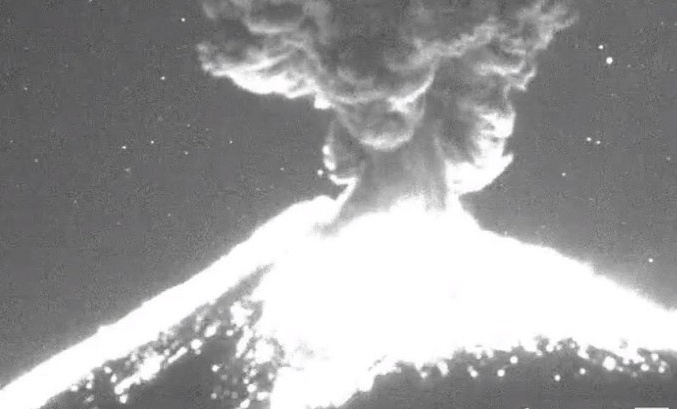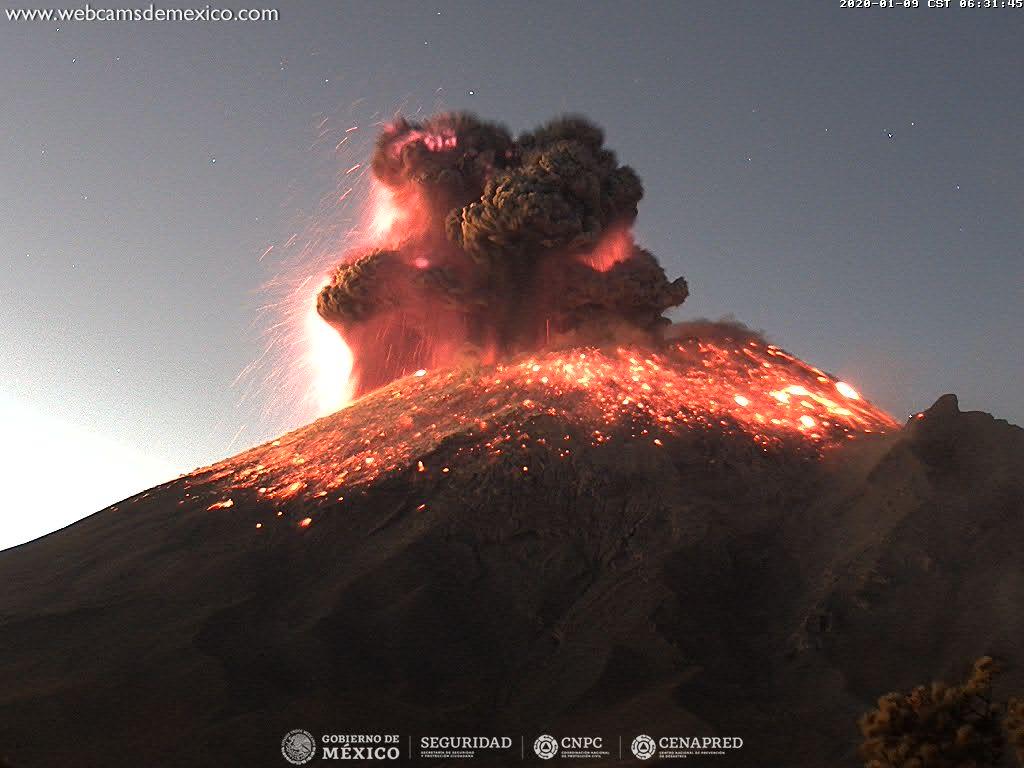Large explosion at Popocatepetl volcano, ash to 7.9 km (26 000 feet) a.s.l., Mexico

A large explosion took place at Mexico's Popocatepetl volcano at around 06:20 UTC on February 25, 2020. According to the Washington VAAC, volcanic ash is rising up to 7.9 km (26 000 feet) above sea level.
At 11:13 UTC, the volcanic ash cloud was 130 km (80 miles) E of the summit.
New emissions after 06:20 UTC were registered moving NE, with the farthest 185 km (115 miles) away and new volcanic ash emission around 46 km (29 miles) from the summit. The farthest emissions are expected to dissipate over the next 6 hours.
Boom!
Nueva explosión del #Volcán #Popocatépetl en #México
Columna de emisión a más de 2km de altura y material incandescente a más de 1km de distancia sobre sus laderas
Alerta volcánica en Amarillo Fase2
Febrero 25/0:43h
Vía @webcamsdemexico & @jabed1 pic.twitter.com/OpoSWlzywz— Geól. Sergio Almazán (@chematierra) February 25, 2020
Amanecer de hoy #desdemibalcon volcán Popocatépetl @raul_aguirre @N3T0V @chematierra @Jorgito702Jorge @Tibunando @CarlosTorresF_ un saludo amigos pic.twitter.com/Am1QtXWH6S
— desde mi balcon (@roxsalvatori) February 25, 2020
In 24 hours to 17:00 UTC on February 24, the monitoring systems of the Popocatépetl volcano identified 148 exhalations, 1 moderate moderate explosion, and 10 minor explosions. The explosions had low ash content and dispersed to the southwest. 525 minutes of tremor were also recorded.





With the support of the National Guard, an overflight of the volcano crater was carried on February 18. During this overflight, specialists from the National Center for Disaster Prevention (CENAPRED) of the National Civil Protection Coordination and researchers from the Geophysics Institute of UNAM, were able to observe the morphological conditions of the volcano.
The internal crater maintains a diameter of 350 m (1 150 feet) and its approximate depth is 100 to 150 m (330 – 492 feet), which is covered by tephra. In general, no substantial changes have been observed.


A powerful explosion at 12:31 UTC (06:31 LT) on January 9, 2020, ejected ash up to 11.3 km (37 000 feet) above sea level and threw incandescent material at a distance of 1 km (0.62 miles) from the edge of the crater.




Geological summary
Volcán Popocatépetl, whose name is the Aztec word for smoking mountain, rises 70 km (44 miles) SE of Mexico City to form North America's 2nd-highest volcano. The glacier-clad stratovolcano contains a steep-walled, 400 x 600 m (1 312 x 1 968 feet) wide crater.
The generally symmetrical volcano is modified by the sharp-peaked Ventorrillo on the NW, a remnant of an earlier volcano.
At least three previous major cones were destroyed by gravitational failure during the Pleistocene, producing massive debris-avalanche deposits covering broad areas to the south. The modern volcano was constructed south of the late-Pleistocene to Holocene El Fraile cone.
Three major plinian eruptions, the most recent of which took place about 800 CE, have occurred from Popocatépetl since the mid-Holocene, accompanied by pyroclastic flows and voluminous lahars that swept basins below the volcano. Frequent historical eruptions, first recorded in Aztec codices, have occurred since precolumbian time. (GVP)
Featured image credit: CENAPRED, webcamsdemexico

Commenting rules and guidelines
We value the thoughts and opinions of our readers and welcome healthy discussions on our website. In order to maintain a respectful and positive community, we ask that all commenters follow these rules:
We reserve the right to remove any comments that violate these rules. By commenting on our website, you agree to abide by these guidelines. Thank you for helping to create a positive and welcoming environment for all.